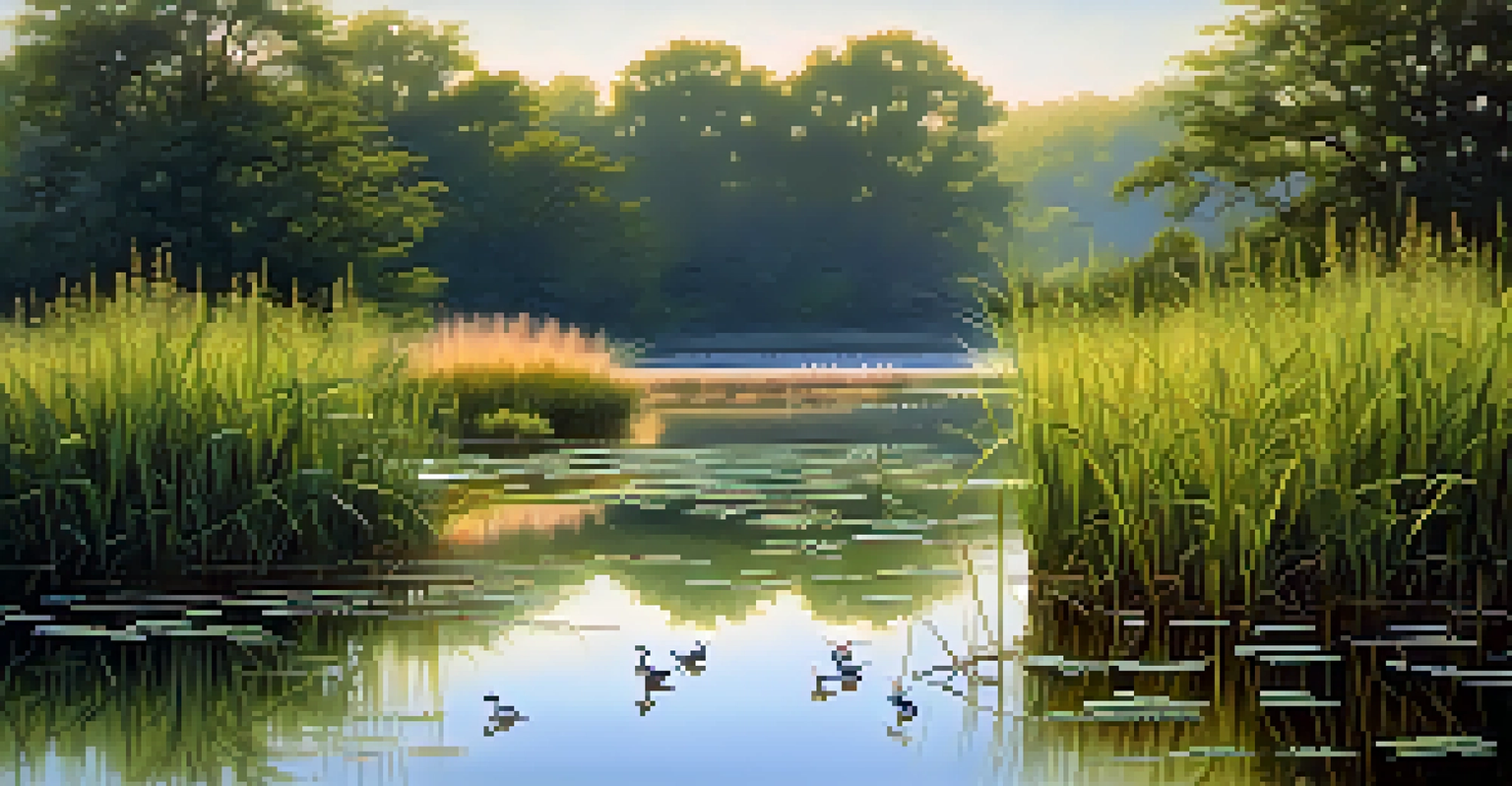Wildlife Watching in Pennsylvania's Scenic Natural Areas

Why Pennsylvania is a Wildlife Watching Paradise
Pennsylvania is a hidden gem for wildlife enthusiasts, boasting diverse ecosystems that range from lush forests to expansive wetlands. This variety of habitats supports a rich tapestry of wildlife, making it a prime location for observing animals in their natural environments. Whether you're an avid birdwatcher or simply enjoy spotting deer and other mammals, Pennsylvania offers countless opportunities.
In every walk with nature one receives far more than he seeks.
With over 120 species of mammals and 400 species of birds, the state is home to both familiar creatures and some rare finds. Imagine spotting a majestic bald eagle soaring overhead or a playful otter sliding into a stream. Each visit can reveal new surprises, making every wildlife watching trip unique.
Moreover, the state’s commitment to conservation ensures that these natural areas remain accessible for future generations. The combination of scenic beauty and thriving wildlife makes Pennsylvania a must-visit for anyone looking to connect with nature.
Top Locations for Wildlife Watching in Pennsylvania
When it comes to prime wildlife watching spots, Pennsylvania doesn't disappoint. Places like the Allegheny National Forest and the Delaware Water Gap National Recreation Area are renowned for their rich biodiversity. Here, visitors can encounter everything from black bears to a variety of bird species, often just a short hike away from well-marked trails.

Another fantastic location is the Presque Isle State Park, where the shores of Lake Erie provide a habitat for migratory birds. During the spring and fall, birders flock to this area to catch glimpses of rare species, making it a hotspot for both casual observers and serious birdwatchers. The serene setting of the park enhances the experience, allowing visitors to feel truly connected to nature.
Pennsylvania's Wildlife Diversity
The state is home to over 120 species of mammals and 400 species of birds, offering abundant opportunities for wildlife observation.
Don’t forget about the state’s many wildlife refuges, such as the John Heinz National Wildlife Refuge. This sanctuary offers a unique opportunity to see a variety of animals in a peaceful, protected environment. Each of these spots showcases the incredible natural beauty of Pennsylvania while providing ample wildlife viewing opportunities.
Best Times for Wildlife Watching
Timing can significantly affect your wildlife watching experience in Pennsylvania. Early morning and late afternoon are often considered the best times for spotting animals, as many species are most active during these cooler parts of the day. The soft light of dawn or dusk also enhances the natural beauty of the landscapes, making your observations even more memorable.
The earth has music for those who listen.
Seasonality plays a crucial role too; spring is a fantastic time for bird migration, while autumn often brings the chance to see animals preparing for winter. Each season showcases different wildlife behaviors and activities, giving you a reason to visit multiple times throughout the year. For example, summer might present the opportunity to see fawns, while winter offers the chance to track animals in the snow.
Being aware of local wildlife calendars, which track migration and mating seasons, can also enhance your experience. This knowledge allows you to plan your visits around the most exciting times to potentially see specific species in action.
Essential Gear for Wildlife Watching
To make the most of your wildlife watching adventures, having the right gear is essential. A good pair of binoculars can greatly enhance your viewing experience, allowing you to observe animals from a safe distance without disturbing them. Look for binoculars that are lightweight and have a good field of view for the best results.
Additionally, a field guide specific to Pennsylvania wildlife can be invaluable. These guides help you identify various species and understand their behaviors, enriching your experience as you spot different animals. Consider bringing a notebook to jot down your observations or even sketch the wildlife you encounter.
Best Times for Wildlife Viewing
Early mornings and late afternoons are ideal for spotting wildlife, with different seasons showcasing unique animal behaviors.
Don’t forget about comfort and safety; wearing appropriate clothing for the weather and sturdy footwear for hiking will make your outings more enjoyable. A small backpack with snacks, water, and a first-aid kit can also be a lifesaver, ensuring you’re well-prepared for a day in the great outdoors.
Respecting Wildlife and Their Habitats
While it’s exciting to observe wildlife, it’s crucial to do so responsibly. Maintaining a respectful distance from animals helps protect both you and the wildlife. Approaching animals too closely can stress them and disrupt their natural behaviors, which is not only harmful but can also lead to dangerous situations.
Always follow park guidelines and regulations regarding wildlife viewing. These rules are in place to ensure the safety of both visitors and animals. For instance, feeding wildlife can alter their natural habits and lead to dependency on human food, which is detrimental to their survival.
Being a responsible wildlife watcher also means leaving no trace. Stick to marked trails, dispose of waste properly, and avoid picking plants or disturbing habitats. By respecting these practices, you help preserve the beauty of Pennsylvania's natural areas for generations to come.
Wildlife Watching Events and Activities
Pennsylvania often hosts a variety of wildlife watching events and activities that can enhance your experience. Many state parks and conservation organizations offer guided tours, workshops, and educational programs to help you connect more deeply with the local ecosystem. These events often cater to all skill levels, making them accessible for families and beginners.
Participating in these activities can provide a unique opportunity to learn from experts and meet fellow nature enthusiasts. From bird banding demonstrations to photography workshops, there’s something for everyone. Plus, these events can help you discover new locations and hidden gems in the state.
Responsible Wildlife Watching
Maintaining a respectful distance and following park guidelines are essential for protecting both wildlife and their habitats.
Don’t forget to check local event calendars or conservation websites for upcoming activities. Joining a community of wildlife watchers can enrich your appreciation for Pennsylvania’s diverse ecosystems while offering a fun way to spend time outdoors.
The Benefits of Wildlife Watching for Everyone
Wildlife watching is not only a thrilling activity but also offers numerous benefits for individuals and communities. Spending time in nature has been shown to reduce stress, enhance mood, and improve overall well-being. Observing wildlife can evoke a sense of wonder and connection to the natural world, fostering a deeper appreciation for the environment.
Moreover, wildlife watching promotes conservation efforts. As more people engage in this activity, the demand for preserved natural areas increases, encouraging local governments to invest in conservation initiatives. This creates a positive feedback loop, where wildlife watching helps protect habitats while providing economic benefits through tourism.

Finally, wildlife watching encourages lifelong learning. Each outing presents new opportunities to learn about different species, ecosystems, and conservation challenges. As you expand your knowledge, you become an advocate for protecting the natural world, inspiring others to appreciate Pennsylvania’s beautiful wildlife.